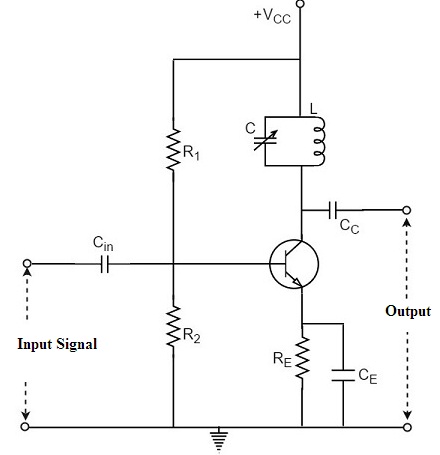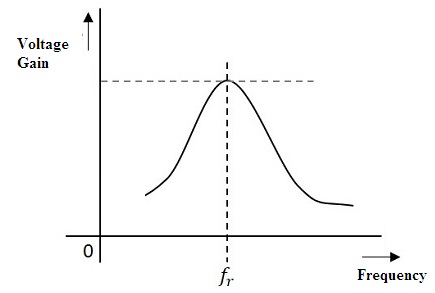Tuned amplifiers are mainly preferred to amplify the high-frequency signals in wireless communication. The tuned amplification works based on the tuning circuit implied as load. The range of the frequencies defined for a particular amplification circuit can be fixed or dynamic based on applications. The tuning circuit present at the load consists of an inductor and capacitor. For dynamic frequencies, the values of capacitance should be varied. These amplifiers are very advantageous due to its appealing large bandwidths. The increment in bandwidth is based on the number of tuning circuits present at the load. There are three types of most frequently used tuned amplifiers they are single tuned amplifier, double-tuned amplifier and stagger tuned amplifier.
What is a Single Tuned Amplifier?
Definition: A tuned amplifier consists of a single tuning circuit at the load can be defined as a single tuned amplifier. It is a multi-stage amplifier, where each stage of this amplifier must be tuned with the same frequencies. For example, tuning a radio station. If the desired carrier wave is passed and matches the defined range of passband frequency, then the radio station is tuned otherwise it is blocked.
Construction and Operation of Single Tuned Amplifier
Single tuned amplifiers can be constructed using a BJT. The circuit of this amplifier consists of a transistor followed by the tuning circuit. If the considered transistor is of the common emitter in configuration then in such case, the output is collected from the coupling capacitor connected at the collector terminal.

Single Tuned Amplifier
Therefore, the tuning circuit (load) is connected to the collector terminal. Each amplifier possesses a certain resonating frequency. The frequency that must be amplified and equal to the resonant frequency of this circuit.
The operation of the single tuned amplifiers undergo these following steps:
- The desired signal required to get amplified must be applied as input.
- By altering the value of capacitance, the frequency in tuning circuit called resonating frequency that is equivalent to the signal frequency applied.
- At this condition, when both frequencies are equal that results in high impedance from the tuned circuit.
- The other signals whose frequency is not equivalent to the resonating frequency undergo low impedance offered by the circuit.
- Hence, the low impedance signals are rejected & the signals with high impedances are allowed and get amplified.
- Then the desired output is high in such cases and it is collected at the coupling capacitor.
Please refer to this link to know more about transistor tuned amplifiers MCQs
Please refer to this link to know more about Single Stage Transistor Amplifier
Please refer to this link to know more about Multi-Stage Transistor Amplifier
Voltage Gain and Frequency Response
The voltage gain for this type of amplifier can be determined from the equation
AV = β Rac / rin
As the gain factor is dependent upon the impedance of the tuning circuit (Rac) that possesses ‘L’ and ‘C’ values in it.
Rac = L/CR
The final equation for the amplifier gain is
AV = β L /CR rin
The frequency response curve is plotted to show how the change in frequency affects the change in the gain of the amplifier.

Frequency Response
From the above graph, it is evident that the gain is maximum at the resonating frequency. So, the frequencies which equivalent to it will be allowed others are blocked.
Cascading Effect on the Bandwidth
The curves of response are plotted that shown in the above image. In that, there are slight increments and decrements in the signal at the central frequency. This range is defined as the bandwidth.
B.W = f2-f1
Bandwidth is a factor to determine the range in which the signals get amplified.
As it is a multi-stage amplifier, one stage of the amplifier’s output is given as input to the next sage. This process is known as cascading, used to increase the gain of the circuit. But gain and bandwidth are inversely proportional to each other.
Due to cascading the voltage, gain tends to increase which results in the decrease of the bandwidth.
When the ‘n’ stages of this amplifier are cascaded, the gain of the amplifier corresponding to the system gain at the certain resonant frequency can be given as
mod A/A resonance = 1/√ 1+(2δQe)²
Where,
Qe = (Effective) Quality Factor
δ = Fractional Frequency Variation
For n- stages the equation can be converted to
(mod A/A resonance )n = (1 /√ 1+(2δQe)²)n
The final equation of the gain can be equated to 1/√2 to conclude the 3-dB ranged frequencies of this tuning amplifier.
(1 /√ 1+(2δQe)²)n = 1/√2
1+(2δQe)² = 21/n
(2δQe)² = 21/n -1
(2δQe) = ±√(21/n -1)
The fractional frequency of variation can be substituted as
δ= ω- ωr / ωr = f- fr /fr
After substitution, the equation can be re-written as
(2(f- fr )Qe/fr) = ±√(21/n -1)
(2(f- fr )Qe) = ±fr √(21/n -1)
f2- fr = + fr √(21/n -1) / 2Qe
fr-f1= + fr √(21/n -1) / 2Qe
Thee bandwidth for the ‘n’ number of stages of single tuned amplifier can be written as
B(1-n) = f2 – f1
B(1-n) = (f2 – fr )+(fr – f1 )
=fr / 2 Qe √(21/n -1) + fr / 2 Qe √(21/n -1)
The final equation for the bandwidth of n stages is
B(1-n) = fr (√(21/n -1))/ Qe
Further, bandwidth of the single stage can be written as
B1 = fr / Qe
Therefore,
B(1-n) = B1 √(21/n -1)
Where ‘n’ denotes the number of stages of the tuned amplifier. By using this formula, we can find the value of bandwidth for any of the stages.
For n=2,
B(1-2) =√(21/2 -1) = 0.643
For n=3,
B(1-3) =√(21/3 -1) = 0.51
From the above values, it is clear that as the number of stages increases the bandwidth is supposed to decrease.
Advantages and Disadvantages of Single Tuned Amplifier
The advantages of the single tuned amplifiers are:
- The selection of the desired frequencies can be done by using this amplifier.
- The gain factor will be high due to the cascading phenomena.
The above are some of the advantages of single tuned amplifiers but the main disadvantage is, its potential instability will be occurred due to the reduction of the bandwidth.
Applications of Single Tuned Amplifier
The applications of these amplifiers are
- These are practically used in radios and televisions.
- In the amplification of video signals, single tuned amplifiers are used.
- The radiofrequency amplification circuits make use of this circuit.
FAQs
1). What is a single tuned circuit?
A circuit whose behavior is similar to the circuit which possesses a single inductor and capacitor is referred to as a single tuned circuit.
2). What range of frequency is tuned amplifiers used?
Tuned amplifiers are used for the radio frequencies amplification and it is ranging from 20 Kilo Hertz to 300G Hertz.
3). Why are tuned circuits not used for low-frequency amplification?
The frequency of resonance and the value of the inductor and capacitor are inversely proportional to each other. So, it is obvious that for low-frequency signal amplification we need to use high values o inductors an capacitors. This makes the circuit expensive an bulky.
4). What is electronic tuning?
An electronic circuit is used to tune the desired frequency to resonant frequency is defined as electronic tuning.
Thus, a single tuned amplifier circuit uses a parallel tuning circuit to select and pass the desired range of frequencies. It is generally used as a ‘frequency receiver’. Special care must be taken during a multi-stage environment where each stage must be tuned with the same resonating frequency. Here is a question for you, What is the basic difference between the single tuned amplifier and the other tuned amplifiers?